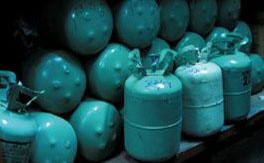HFCs: a critical link in protecting climate and the ozone layer

HFCs could be responsible for emissions equivalent to 3.5 to 8.8 gigatons of carbon dioxide (Gt CO2eq) by 2050, according to this new UNEP report.
The UNEP has released a report titled “HCFs: A Critical Link in Protecting Climate and the Ozone Layer,” on the importance of addressing hydrofluorocarbons (HFCs). The report is part of a series of three reports being released by UNEP in the lead-up to the Durban Climate Change Conference. According to UNEP, urgent action is needed to phase-down the use of HFCs, chemicals increasingly being used in products such as air conditioners, refrigerators, fire-fighting equipment and insulation foams. HFCs are common replacements for ozone-depleting substances (ODS) that are being phased out under the Montreal Protocol. According to the report, HFCs could be responsible for emissions equivalent to 3.5 to 8.8 gigatons (Gt) of carbon dioxide (Gt CO2eq) by 2050, an amount comparable to total current annual emissions from transport, estimated at around 6-7 Gt annually. The report suggests several options for reducing the impacts of HFCs including: alternative methods and processes, for example through improved building design that reduce the need for air conditioners; the use of non-HFC substances, such as ammonia or dimethyl ether for use in foams, refrigeration and fire protection systems; and climate-friendly HFCs with shorter atmospheric life-times, such as HFC 1234ze in foams and HFC-1234yf for mobile air-conditioners.
See Also
Report: Effects of ozone depletion.
Report: The HFC imperative
Report: HFCs: a growing threat.
Report: An unparalleled opportunity for Copenhagen...
Report: Chilling facts
Feature: If HFCs are regulated
Report: Montreal Protocol must regulate HFCs.
Feature: Curb HFCs.
Feature: Contribution of HFC emissions
